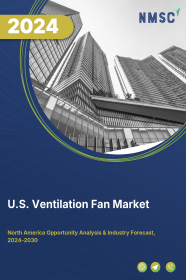
The U.S. Ventilation Fan Market by Product Type (Centrifugal Fans, Axial Fans, Hatch Fans, and Duct Fans), by Flow Rate (Below 100 CFM, 100-250 CFM, 250-500 CFM, 500-750 CFM, and Above 750 CFM), by Material (Metal and Plastic), by Installation (Ceiling Mounted, Wall Mounted, and In line installation), by Application (Industrial, Commercial, and Residential), and by Distribution Channel (Online and Offline)– Opportunity Analysis and Industry Forecast, 2024–2030
Industry: Construction & Manufacturing | Publish Date: 05-Apr-2024 | No of Pages: 118 | No. of Tables: 85 | No. of Figures: 50 | Format: PDF | Report Code : N/A
US Tariff Impact on U.S. Ventilation Fan Market
Trump Tariffs Are Reshaping Global Business
Market Definition
The U.S. Ventilation Fan Market size was valued at USD 561.7 million in 2023, and is predicted to reach USD 928.2 million by 2030, at a CAGR of 6.9 % from 2024 to 2030.
A ventilation fan, a mechanical apparatus, functions to circulate air within confined areas, enhancing air quality while managing temperature and humidity levels. Integral to sustaining favourable operational conditions, ventilation fans find indispensable use across diverse settings including factories, warehouses, offices, and commercial establishments.
Their primary function encompasses the elimination of stagnant air, regulation of moisture content, and mitigation of hazardous pollutants, thereby fostering a secure and comfortable environment for individuals within these spaces. Recognized for their pivotal role in optimizing workplace efficiency, health, and safety standards, ventilation fans stand as indispensable resources for enterprises spanning various industries.
The Market Growth is Propelled by Increasing Awareness Regarding Indoor Air Quality
The increasing awareness of indoor air quality (IAQ) is a significant driving factor in the ventilation fan market. In October 2023, the Environmental Protection Agency (EPA) of the United States set indoor guidelines for radon, and states including California, Illinois, and Texas have established IAQ guidelines, including recommendations for carbon dioxide levels, carbon monoxide levels, and environmental tobacco smoke (ETS) exposure.
Growing concerns about airborne pollutants, allergens, and health risks associated with poor IAQ are fuelling demand for solutions, including ventilation fans. The prevalence of asthma and other respiratory illnesses also underscores the critical need for proper ventilation in homes and buildings to mitigate health risks and improve indoor air quality.
This increased awareness of IAQ drives the adoption of ventilation fans across residential, commercial, and industrial sectors, ensuring healthier and safer indoor environments for occupants nationwide.
Regulatory Frameworks and Initiatives Driving Growth in the U.S. Ventilation Fan Market
Moreover, in the US regulations and initiatives such as the Energy Star program, the Indoor Air Quality Act, and local building codes play pivotal roles in driving the ventilation fan market. The Energy Star program, which sets energy efficiency standards for ventilation fans, incentivizes manufacturers to enhance their products, promoting the adoption of energy-efficient ventilation solutions.
The Indoor Air Quality Act also underscores the importance of safe and healthy indoor environments, indirectly encouraging ventilation systems to improve air quality. Furthermore, adherence to local building codes and health regulations across states influences ventilation fan adoption, reinforcing the demand for nationwide compliant and high-quality ventilation solutions.
These regulatory frameworks and initiatives collectively propel the growth of the ventilation fan market in the United States, ensuring the provision of efficient and safe indoor air ventilation across residential, commercial, and industrial sectors.
The Market Growth is Hindered by the High Expenses Associated with Maintenance
Regular maintenance of ventilation fans is essential to uphold their efficiency and prolong their operational lifespan. This routine upkeep typically involves activities like cleaning filters, lubricating moving parts, and replacing worn components.
While crucial for ensuring peak performance, these maintenance tasks can bring additional expenses and require dedicated time and resources. It's imperative for businesses to account for these ongoing maintenance costs and allocate personnel or resources for regular upkeep.
Ignoring proper ventilation fan maintenance may lead to reduced efficiency, increased energy consumption, and potentially expensive repairs or replacements in the long run. Hence, investing in consistent maintenance is crucial to ensure the sustained effectiveness and reliability of ventilation systems in commercial and industrial environments.
The Increasing Focus on Energy Efficiency Regulations by Governmental Authorities Presents a Favourable Opportunity for the Industry
As governments and regulatory bodies increasingly enforce stringent energy efficiency standards, there is a rising need for ventilation fan solutions that not only comply with these regulations but also surpass them. This creates an opportunity for manufacturers to take the lead in developing energy-efficient products.
Companies capable of meeting these standards have the potential to capture a greater market share by providing solutions that adhere to evolving regulations, cater to environmentally-conscious consumers and businesses, and stay ahead of compliance mandates.
Competitive Landscape
The U.S ventilation fan market comprises various market players, such as Ebm-papst Group, Broan-NuTone, ZIEHL-Abegg, Delta Electronics, Inc., Panasonic Holding Corporation, Crompton Greaves Consumer Electricals Limited, Mitsubishi Electronics Ltd., Zehnder Group, Havells India Ltd., and Glen Dimplex UK Limited, and others.
The U.S. Ventilation Fan Market Key Segments
By Product Type
-
Centrifugal fans
-
Axial fans
-
Hatch Fans
-
Duct Fans
By Flow Rate
-
Below 100 CFM
-
100-250 CFM
-
250-500 CFM
-
500-750 CFM
-
Above 750 CFM
By Material
-
Metal
-
Plastic
By Installation
-
Ceiling Mounted
-
Wall Mounted
-
In line installation
By Application
-
Industrial
-
Commercial
-
Residential
By Distribution Channel
-
Online
-
Offline
REPORT SCOPE AND SEGMENTATION:
|
Parameters |
Details |
|
Market Size in 2023 |
USD 561.7 Million |
|
Revenue Forecast in 2030 |
USD 928.2 Million |
|
Growth Rate |
CAGR of 6.9 % from 2024 to 2030 |
|
Analysis Period |
2023–2030 |
|
Base Year Considered |
2023 |
|
Forecast Period |
2024–2030 |
|
Market Size Estimation |
Million (USD) |
|
Growth Factors |
|
|
Companies Profiled |
10 |
|
Market Share |
Available for 10 companies |
|
Customization Scope |
Free customization (equivalent up to 80 working hours of analysts) after purchase. Addition or alteration to country, regional, and segment scope. |
|
Pricing and Purchase Options |
Avail customized purchase options to meet your exact research needs. |
KEY PLAYERS
-
Ebm-papst Group
-
Broan-NuTone
-
ZIEHL-Abegg
-
Delta Electronics Inc.
-
Panasonic Holding Corporation
-
Crompton Greaves Consumer Electricals Limited
-
Mitsubishi Electronics Ltd.
-
Zehnder Group
-
Havells Australia Ltd.
-
Glen Dimplex UK Limited














 Speak to Our Analyst
Speak to Our Analyst





















